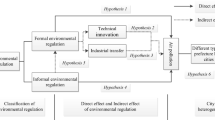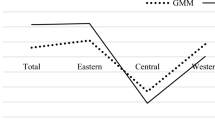Abstract
This study, set against the backdrop of new standard policies for air pollution control, investigates the role of air pollution control in driving economic transformation, upgrading, and safeguarding public welfare. Utilizing data from the prefecture-level cities from 2007 to 2016, the impact of air pollution control on per capita GDP, employment, and industrial upgrading is examined using the difference-in-differences method, and the long-term mechanism is tested. The results indicate that the new standard policy significantly improves regional per capita GDP and employment rate, and the condition identification test and robustness test show that this conclusion is very robust. Further analysis reveals that the new standard policy promotes per capita GDP and employment rate in the western region, driving regional industrial upgrading. The impact mechanism test shows that air pollution control promotes industrial upgrading and stable employment through the long-term mechanism of improving marketization, expanding the level of openness, and developing alternative industries, but there is still room for improvement in foreign investment and the development of the tertiary industry.



Similar content being viewed by others
Data availability
The datasets used or analyzed during the current study are available from the corresponding author on reasonable request.
Notes
The document is from the Ministry of Ecology and Environment of the Ministry of Ecology and Environment,https://www.mee.gov.cn/ywgz/fgbz/fl/201811/t20181113_673567.shtml.
The document is from the Ministry of Ecology and Environment of the Ministry of Ecology and Environment,https://www.mee.gov.cn/gkml/sthjbgw/sthjbgg/201808/t20180815_451398.htm
The data comes from the National Environmental Air Quality Monitoring Network of the China Environmental Monitoring Station.
References
Arns D (2017) Regulation does shape profitability. Chim Oggi – Chem Today 35(6):71–72
Bai XJ, Wang HF, Yan WK (2014) Resource recession, science & technology and education support and urban transformation-research on transformation efficiency of resource-based cities based on the dynamic SBM model covering bad output. China Industrial Economics 11:30–43 (in Chinese)
Baron RM, Kenny DA (1986) The moderator-mediator variable distinction in social psychological research: conceptual, strategic, and statistical considerations. J Pers Soc Psychol 51(6):1173–1182
Beck T, Laeven L (2006) Institution building and growth in transition economies. J Econ Growth 11(2):157–186
Beck T, Levine R, Levkov A (2010) Big bad banks? The winners and losers from bank deregulation in the United States. J Financ 65(5):1637–1667
Cavanaugh R (2017) Extreme air pollution in Mongolia's overflowing capital. Lancet Respir Med 5(8):614–615
de Chaisemartin C, D'Haultfoeuille X (2022) Two-way fixed effects regressions with several treatments. Arxiv arXiv:2012.10077
Chen YJ, Li P, Lu Y (2018) Career concerns and multitasking local bureaucrats: evidence of a target-based performance evaluation system in China. J Dev Econ 133:84–101
Dechezlepretre A, Sato M (2019) The impacts of environmental regulations on competitiveness (vol 1, pg 521, 2014). Rev Environ Econ Policy 13(1):165–165
Gray WB, Shadbegian RJ, Wang C et al (2015) Do EPA regulations affect labor demand? Evidence from the pulp and paper industry (vol 68, pg 188, 2014). J Environ Econ Manage 69:62–62
Hjort J (2006) Citizen funds and Dutch disease in developing countries. Res Policy 31(3):183–191
Jiang Z, Wang Z, Lan X (2021) How environmental regulations affect corporate innovation? The coupling mechanism of mandatory rules and voluntary management. Technol Soc 65:101575
Kang D, Bae K-S, Houk BE et al (2012) Standard error of empirical Bayes estimate in NONMEM (R) VI. Korean J Physiol Pharmacol 16(2):97–106
Kumar S, Prasad S, Yadav KK (2019) Utilization of air pollutants by plants: need for present and future scrutiny. J Agric Food Chem 67(10):2741–2742
Kurtz MJ, Brooks SM (2011) Conditioning the “resource curse”: globalization, human capital, and growth in oil-rich nations. Comp Pol Stud 44(6):747–770
Li P, Lu Y, Wang J (2016) Does flattening government improve economic performance? Evidence from China. J Dev Econ 123
Li XP, Joppe M, Meis SM (2017) Human resource management impacts on labour productivity in tourism. Tour Econ 23(5):1028–1041
Liu Q, Qiu LD (2016) Intermediate input imports and innovations: evidence from Chinese firms’ patent filings. J Int Econ 103:166–183
Liu B, Lin Y, Chan KC et al (2018) The dark side of rent-seeking: the impact of rent-seeking on earnings management. J Bus Res 91:94–107
Lu Y, Tao Z, Zhu L (2017) Identifying FDI spillovers. J Int Econ 107:75–90
Mehlum H, Moene K, Torvik R (2006) Cursed by resources or institutions? World Econ 29(8)
Pang ZQ, Wang BD (2012) Study on evaluation system of resource exhaustion regions’ economic transformation. Stat Res 29:73–79
Qi Y, Lu H (2015) Pollution, health and inequality-crossing the trap of “environmental health poverty.” J Manag World 9:32–51
Ramirez-Cendrero JM, Wirth E (2016) Is the Norwegian model exportable to combat Dutch disease? Resour Policy 48:85–96
Ryu D, Ryu D, Yang H (2020) Investor sentiment, market competition, and financial crisis: evidence from the Korean stock market. Emerg Mark Financ Trade 56(8):1804–1816
Sala-i-Martin X, Subramanian A (2013) Addressing the natural resource curse: an illustration from Nigeria. J Afr Econ 22(4):570–615
Song J, Wu D (2022) An innovative transboundary pollution control model using water credit. Comput Ind Eng 171:108235
Sun L, Du J, Li Y (2021) A new method for dividing the scopes and priorities of air pollution control based on environmental justice. Environ Sci Pollut Res 28(10):12858–12869
Wang F, Dong M, Ren J et al (2022) The impact of urban spatial structure on air pollution: empirical evidence from China. Environ Dev Sustain 24(4):5531–5550
Wu H, Za H, Zhou Y (2021) Optimal degree of openness in open innovation: a perspective from knowledge acquisition & knowledge leakage. Technol Soc 67:101756
Yamazaki A (2017) Jobs and climate policy: evidence from British Columbia’s revenue-neutral carbon tax. J Environ Econ Manag 83:197–216
Yu L and Ma B (2022) Supportive policy for resource-exhausted cities, the manufacturing upgrading and the coordinated regional development. 08:137–155 (in Chinese)
Zhang M, Wang L, Ma P et al (2022) Urban-rural income gap and air pollution: a stumbling block or stepping stone. Environ Impact Assess Rev 94:106758
Zhao L, Liu C, Liu X et al (2021) Urban spatial structural options for air pollution control in China: evidence from provincial and municipal levels. Energy Rep 7:93–105
Zhijun X (2001) Reflections on further regulating and improving the market exit mechanism of enterprises. South China Journal of Economics 7:12–14 (in Chinese)
Zhou B, Xu Y, Lee SK (2019) Tourism development and regional production efficiency: evidence from southwestern China. Tour Econ 25(5):800–818
Funding
This work was supported by the World Bank and Ministry of Finance of China, “innovative research on budget performance evaluation under the background of comprehensive implementation of budget performance management” (No.32522109016).
Author information
Authors and Affiliations
Contributions
Liang Zhang (corresponding author) performed the experiment; Wubin Yuan contributed significantly to analysis and manuscript preparation; Zheqi Zhang reviewed the manuscript.
Corresponding author
Ethics declarations
Ethical approval
Not applicable.
Consent to participate
Not applicable
Consent to publication
Not applicable
Conflict of interest
The authors declare no competing interests.
Additional information
Responsible Editor: Nicholas Apergis
Publisher’s note
Springer Nature remains neutral with regard to jurisdictional claims in published maps and institutional affiliations.
Supplementary information
ESM 1:
Appendix Figure 1: Trends in Per Capita GDP and Employment Changes in Air Pollution Control in 2012. Appendix Figure 2:Trends in Per Capita GDP and Employment Changes in Air Pollution Control in 2013. Appendix Table 1:Desccriptive statistics of main variables.
Rights and permissions
Springer Nature or its licensor (e.g. a society or other partner) holds exclusive rights to this article under a publishing agreement with the author(s) or other rightsholder(s); author self-archiving of the accepted manuscript version of this article is solely governed by the terms of such publishing agreement and applicable law.
About this article
Cite this article
Zhang, L., Yuan, W. & Zhang, Z. Implementation effect of air pollution policy, long-term mechanism, and industrial structure promotion—a quasi-natural experiment based on ambient air quality standards. Environ Sci Pollut Res 30, 87368–87381 (2023). https://doi.org/10.1007/s11356-023-28428-6
Received:
Accepted:
Published:
Issue Date:
DOI: https://doi.org/10.1007/s11356-023-28428-6




